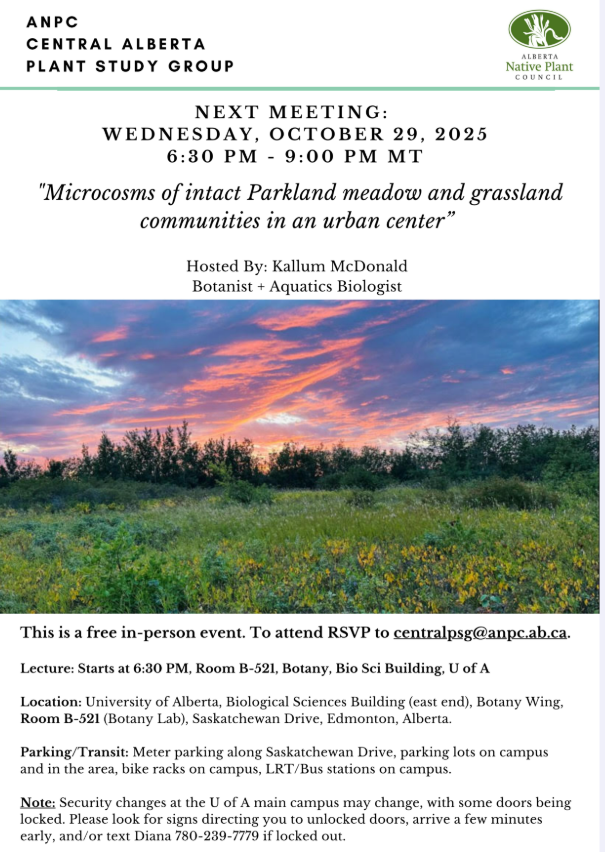Sharing Knowledge,
Supporting Conservation
We share knowledge and support the conservation of native plants and native plant habitat in Alberta through outreach, publications and guidelines, stewardship, advocacy, research, and funding and implementing native plant projects.
Featured News and Events
-
October 20th, 2025 – NEW Grande Prairie Plant Study Group
ANPC is pleased to announce that we are restarting our Grande Prairie Plant Study Group in collaboration with the Peace Parkland Naturalists. The first talk will be held on Monday, October 20th from 6:30-8:00 pm.…
-
October 29th, 2025 – Central Alberta Plant Study Group
The next Central Alberta (Edmonton) Plant Study Group will be held on Wednesday, October 29th at 6:30 pm at the University of Alberta Herbarium (BioSci B-512). The topic this month is Microcosms of Intact Parkland…
-
Vascular Flora of Alberta: An Illustrated Guide 2nd Edition Released!
With the newly released second edition, this guide includes illustrated keys to all native and naturalized vascular plants in Alberta. Additions from the first edition include keys to all new species, bonus keys to subspecies…
-
A Tour of Alberta’s Natural Regions, and their Plants
This new Storymap developed by University of Alberta students for the ANPC takes you on a tour of Alberta’s Natural Regions and Subregions, highlighting their characteristic and rare plant species, as well as threats facing…
Featured Activities
Featured Resources
NEW! Native Plant Suppliers and Demonstration Bed Interactive Map:
Featured Publications

The Rare Vascular Plants of Alberta, 2nd Edition
Now available for purchase and can be ordered through UBC Press.

Vascular Flora of Alberta: An Illustrated Guide, 2nd Edition
Available as a paperback or e-book through Amazon.ca. The guide includes illustrated keys to all native and naturalized vascular plants in Alberta.

Vascular Flora of Alberta: Illustrations and Maps
An accompanying resource to the keys, with enhanced illustrations and maps. Available through Amazon.ca.

Wildflowers of Whitehorse Wildland Provincial Park
Available through the Alberta Native Plant Council.
Acknowledging Land and People
We acknowledge that what we call Alberta is the traditional and ancestral territory of many peoples, presently subject to Treaties 6, 7, and 8. Namely: the Blackfoot Confederacy – Kainai, Piikani, and Siksika – the Cree, Dene, Saulteaux, Nakota Sioux, Stoney Nakoda, and the Tsuut’ina Nation and the Métis People of Alberta. This includes the Métis Settlements and the Six Regions of the Métis Nation of Alberta within the historical Northwest Metis Homeland. We acknowledge the many First Nations, Métis and Inuit who have lived in and cared for these lands for generations. We are grateful for the traditional Knowledge Keepers and Elders who are still with us today and those who have gone before us. We make this acknowledgement as an act of reconciliation and gratitude to those whose territory we reside on or are visiting.































